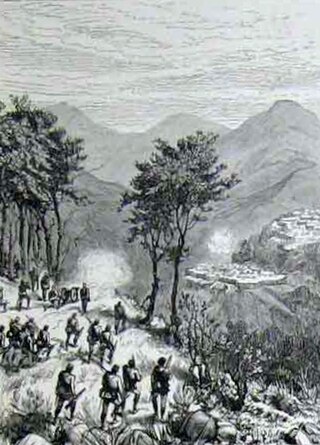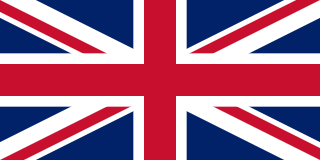
The Chakma people or Changhma people, are an ethnic group from the eastern-most regions of the Indian subcontinent and Western Myanmar. They are the second largest ethnic group of the Chittagong Hill Tracts region of southeastern Bangladesh, and the largest in the Chakma Autonomous District Council of Mizoram, India. Significant Chakma populations are found in the northeast Indian states of Arunachal Pradesh, Tripura and Assam.
Raja Tridiv Roy sometimes spelled Tridev Roy, was a Pakistani politician, diplomat and writer who was the Minister of the Minority Affairs in Zulfikar Ali Bhutto cabinet. He was also the 50th Raja/King of the Chakma tribe in the Chittagong Hill Tracts region of present-day Bangladesh from 2 May 1953, until his abdication in 1971 following the Bangladesh Liberation War. He chose to remain a Pakistani when Bangladesh achieved independence in 1971. He became known as a writer, diplomat, Buddhist religious leader and politician in Pakistan.

Buddhism is the third-largest religious affiliation and formed about 0.63% of the population of Bangladesh. It is said that Buddha once in his life came to this region of East Bengal to spread his teachings and he was successful in converting the local people to Buddhism, specially in the Chittagong division and later on Pala empire propagate and patronized Buddhist religion throughout the Bengal territory. About 1 million people in Bangladesh adhere to the Theravada school of Buddhism. Over 65% of the Buddhist population is concentrated in the Chittagong Hill Tracts region, where it is the predominant faith of the Rakhine, Chakma, Marma, Tanchangya, other Jumma people and the Barua. The remaining 35% are Bengali Buddhists. Buddhist communities are present in the urban centers of Bangladesh, particularly Chittagong and Dhaka.

The Kuki people, or Kuki-Zo people, are an ethnic group in the Northeastern Indian states of Manipur, Nagaland, Assam, Meghalaya, Tripura and Mizoram, as well as the neighbouring countries of Bangladesh and Myanmar. The Kukis form one of the largest hill tribe communities in this region. In Northeast India, they are present in all states except Arunachal Pradesh. The Chin people of Myanmar and the Mizo people of Mizoram are kindred tribes of the Kukis. Collectively, they are termed the Zo people.

Mautâm is a cyclic ecological phenomenon that occurs every 48–50 years in the northeastern Indian states of Tripura, Mizoram and Manipur, as well as in many places of Assam which are 30% covered by wild bamboo forests, and Chin State in Myanmar, particularly Hakha, Thantlang, Falam, Paletwa and Matupi Townships. It begins with a rat population boom, which in turn creates a widespread famine in those areas.

Tlabung, formerly known as Demagiri, is a census town in Lunglei district in the Indian state of Mizoram.

Eastern Bengal and Assam was a province of India between 1905 and 1912. Headquartered in the city of Dacca, it covered territories in what are now Bangladesh, Northeast India and Northern West Bengal.

The insurgency in the Chittagong Hill Tracts, also known as the Chittagong Hill Tracts conflict, refers to a political and armed conflict that occurred in Bangladesh in two phases:
Chittagong Hill Tracts Regulation, 1900 popularly known as Chittagong Hill Tracts manual is a manual enacted by the then British India Government describing how to administer the Chittagong Hill Tracts of present-day eastern Bangladesh. It was adopted in place of earlier manuals, after the government realised that the act of 1860 would not work satisfactorily. Since the adoption of the manual, the administration of Chittagong Hill Tracts was carried on in accordance with the rules of the manual.

Rajguru Aggavamsa Mahathera was one of the delegates from Bangladesh) in the Sixth Buddhist council held in Yangon, Burma in 1956.

The British Indian Army Lushai Expedition of 1871 to 1872 was a punitive incursion under the command of Generals Brownlow and Bourchier. The objectives of the expedition were to rescue British subjects who had been captured by the Lushais in raids into Assam—including a six-year-old girl called Mary Winchester—and to convince the hill tribes of the region that they had nothing to gain and everything to lose by placing themselves in a hostile position towards the British Government.

Mary Winchester, or Zolûti to Mizos later Mary Innes Howie, (1865–1950) was a Scottish girl who was captured and held hostage by the Mizo tribes of Mizoram, India, in 1871, and rescued by the British expedition in 1872. This historic event marked the beginning of British rule in Mizoram that lasted until the Indian Independence in 1947. Indirectly, it also paved the way for Christian missionaries to introduce Christianity among the Mizos.
RajmataBenita Roy was a Bangladeshi aristocrat, litterateur, diplomat and minister. She was the forty-ninth Rani of the Chakma Circle in the Chittagong Hill Tracts. Roy served as the Rajmata during the kingship of Tridev Roy and Debashish Roy. She was a member of Bangladesh's first delegation to the UN General Assembly in 1972, and a minister in the Bangladeshi government from 1975 to 1978.
Raja Harish Chandra Rai was the 47th Raja of the Chakma Circle.
Raja Bhuvan Mohan Roy (1876–1934) was the Chief of the Chakma Circle in the Chittagong Hill Tracts from 1897 until 1933.
Rani Kalindi was the 46th and last independent ruler of the Chakma Circle. She was only female ruler of the Chakma people.

The Chin-Lushai Expedition of 1889–90 was a British punitive expedition in Burma and India against the tribes of the Chin Hills and Lushai Hills.

British rule in the Lushai Hills, spanning from the late 1889 to the 1947, commenced with the Chin-Lushai Expedition of 1889-90 leading to the formal establishment of the two administrative districts in 1889 and continued through the integration of the regions into the province of Assam with both districts being merged as the Lushai Hills until India gained independence in 1947.

Mizo chieftainship refers to the system of chieftainship used by the Mizo people, which historically operated as a gerontocracy. The chieftain system persisted among the various clans and tribes from the precolonial era through to the British colonial period and Indian independence briefly. The Mizo Union advocated for abolishing chieftainship in Mizoram. The chieftainships of Mizoram were eventually disbanded with the Assam-Lushai District Act in 1954.
Khalkam was a Lushai chief of the 19th century. He is known for being the son of Sukpilal and for being an enemy of the British, which led to the Lushai Rising. Khalkam was deported to Hazaribagh jail after British capture, where he committed suicide with his brother Lengpunga.















